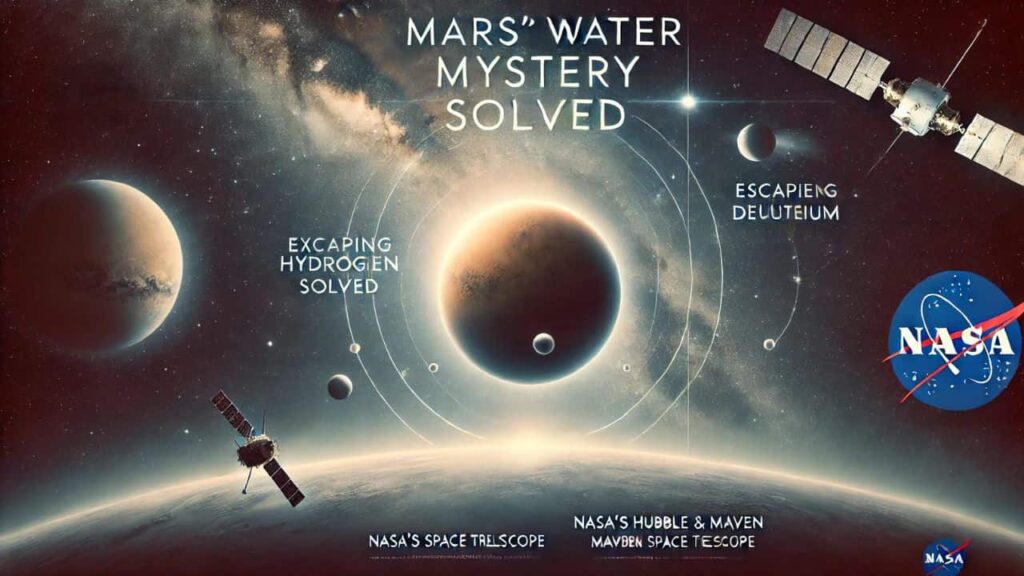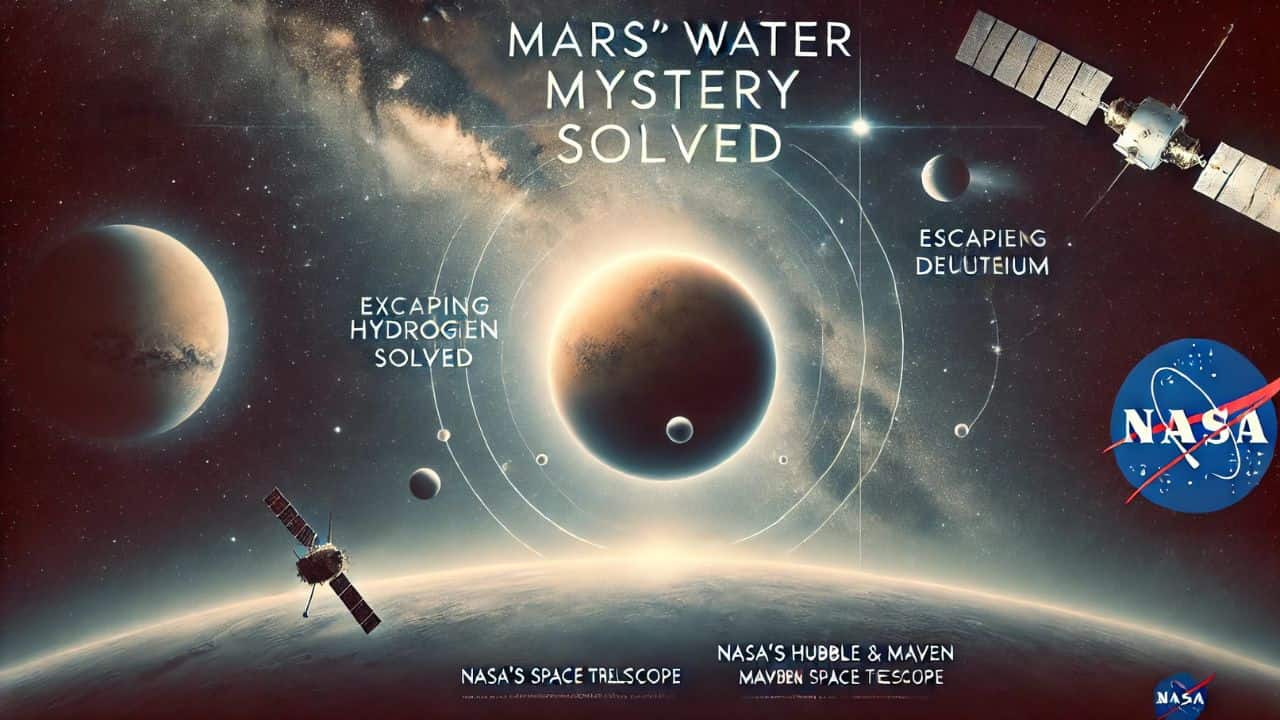NASA, Hubble, MAVEN, Mars water escape, Martian atmosphere, Mars hydrogen escape, Mars deuterium escape, Mars water loss, Mars atmosphere study, Mars climate history, NASA Mars missions, Mars escaping water, Martian water history, hydrogen on Mars, deuterium on Mars
NASA’s Hubble Space Telescope and MAVEN mission have helped scientists uncover the mystery of Mars’ disappearing water. By studying the escape of hydrogen and deuterium from Mars’ atmosphere, researchers have gained new insights into how the planet lost most of its water and evolved over billions of years. Learn how this discovery helps scientists understand the history of water on Mars and its implications for other Earth-like planets.

NASA’s Hubble and MAVEN Help Solve the Mystery of Mars’ Escaping Water
Mars, the fourth planet from the Sun, was once a wet and potentially habitable world. Its surface bears the scars of ancient rivers, lakes, and possibly even oceans. Yet today, Mars is a barren desert, with only traces of water locked away in polar ice caps and beneath its surface. A major scientific puzzle has been understanding what happened to the rest of the water that once flowed on Mars. In an exciting development, NASA’s Hubble Space Telescope and MAVEN (Mars Atmosphere and Volatile Evolution) mission are helping to unlock the mystery of Mars’ escaping water and its past climate.
The Disappearance of Martian Water
Scientists know that over the last three billion years, much of Mars’ water either froze underground or escaped into space. The key question has been determining how much water was lost to space and understanding the processes that led to this escape. John Clarke, a study leader from the Center for Space Physics at Boston University, offers a simple explanation: “There are only two places water can go. It can freeze into the ground, or the water molecule can break into atoms, and the atoms can escape from the top of the atmosphere into space.”
The focus of Clarke and his team has been to understand how hydrogen atoms, a component of water molecules, are escaping Mars’ atmosphere. By combining data from the Hubble Space Telescope and the MAVEN mission, they have gained new insights into the escape rate of hydrogen atoms and, consequently, the fate of Martian water.
Hydrogen and “Heavy Hydrogen” Escaping Mars
The process of water escape from Mars starts with the breakdown of water molecules in the atmosphere due to sunlight. Water, which is made up of hydrogen and oxygen, breaks down into its individual atoms, with hydrogen being the lightest and most likely to escape the planet’s gravity.
However, the team also studied deuterium, a heavier form of hydrogen that contains a neutron in its nucleus. This difference in mass plays a critical role in how these atoms escape into space. Since deuterium is heavier than regular hydrogen, it escapes at a much slower rate. Over time, as more hydrogen is lost, the ratio of deuterium to hydrogen increases in Mars’ atmosphere.
This ratio is crucial for understanding the history of water on Mars. By measuring the current ratio of deuterium to hydrogen and estimating the escape rates over time, scientists can extrapolate how much water was present on Mars during its early, wetter period.
The Role of Hubble and MAVEN
While the MAVEN spacecraft has been instrumental in providing detailed data about Mars’ atmosphere, it has limitations in measuring deuterium emissions during certain times of the Martian year. Mars follows an elliptical orbit, and during its long winters, the deuterium emissions become faint, making it difficult for MAVEN to detect them.
This is where Hubble plays a critical role. By using Hubble’s observations dating back to 1991, Clarke and his team were able to “fill in the blanks” for periods when MAVEN could not collect sufficient data. The combination of data from both Hubble and MAVEN provided a complete annual cycle for three Martian years, which is equivalent to 687 Earth days per Martian year.
With the help of these two missions, scientists obtained a more holistic view of hydrogen and deuterium escaping Mars’ atmosphere into space. This comprehensive dataset allowed them to trace the history of water on Mars more accurately and understand how the planet’s climate has evolved over billions of years.
A Dynamic Martian Atmosphere
One of the most surprising findings from this study is the dynamic and turbulent nature of Mars’ atmosphere. In the past, scientists believed that hydrogen and deuterium atoms slowly diffused upward through the atmosphere until they reached a height where they could escape. However, Clarke’s research has shown that this process is far more complex.
Mars’ atmosphere is highly variable and reacts quickly to changes in the planet’s distance from the Sun. When Mars is closer to the Sun during its orbit, water molecules in the atmosphere rise to higher altitudes much faster than previously thought, releasing hydrogen and deuterium at these upper levels. This rapid movement and release of atoms significantly impact the rate of escape into space.
Additionally, the team discovered that hydrogen and deuterium atoms escape faster than expected due to external forces, such as solar wind particles and chemical reactions driven by sunlight. These forces provide the additional energy needed for the atoms to reach the speeds necessary to escape Mars’ gravitational pull. This new understanding challenges the traditional view of Martian atmospheric escape and offers a deeper understanding of how Mars’ water disappeared over time.
Mars as a Proxy for Studying Exoplanets
Studying the history of water on Mars is essential for understanding not only the evolution of our solar system but also the potential for water on planets around other stars. As astronomers discover more Earth-sized exoplanets in the habitable zones of distant stars, the lessons learned from Mars can provide valuable insights.
Mars, along with Earth and Venus, resides in or near the habitable zone of our solar system, where liquid water could exist on a planet’s surface. Yet, despite this, the three planets have vastly different climates and atmospheric conditions today. By studying Mars, scientists hope to better understand the factors that lead to water retention or loss on rocky planets, which will aid in the search for habitable worlds beyond our solar system.
The Significance of the Hubble and MAVEN Missions
The collaboration between the Hubble Space Telescope and MAVEN mission represents a significant milestone in understanding Mars’ atmospheric evolution. Both missions have contributed immensely to space exploration and our knowledge of the Red Planet.
Hubble, which has been operational for over 30 years, continues to make groundbreaking discoveries. Its partnership with NASA and the European Space Agency (ESA) has led to remarkable insights into the universe, from distant galaxies to planetary atmospheres. For Mars, Hubble has been a critical tool in observing deuterium and hydrogen emissions, providing key data that MAVEN could not.
MAVEN, launched in 2014, has been instrumental in studying Mars’ upper atmosphere. With its 10-year anniversary approaching in 2024, MAVEN continues to provide valuable information about the planet’s climate and atmospheric processes. The mission has been essential in understanding how solar wind and ultraviolet radiation contribute to the escape of gases from Mars’ atmosphere.
Conclusion
The collaboration between NASA’s Hubble Space Telescope and MAVEN mission has brought scientists one step closer to solving the mystery of Mars’ escaping water. By studying the escape rates of hydrogen and deuterium, scientists have gained new insights into how Mars lost most of its water and transformed from a wet planet to the dry, desert-like world we see today.
This research not only sheds light on Mars’ climate history but also helps scientists understand the evolution of planets in other solar systems. As we continue to discover more Earth-sized planets in the habitable zones of distant stars, the lessons learned from Mars will guide us in the search for habitable worlds beyond our solar system. The ongoing contributions of Hubble and MAVEN will undoubtedly continue to expand our understanding of the Red Planet and the universe.
Read More
- NASA Astronaut Don Pettits Innovative Space Experiments A Journey of Discovery
- SpaceXs New Falcon 9 Booster Successfully Launches 22 Starlink Satellites Boosting Global Connectivity
- NASAs Europa Clipper Mission Exploring Jupiters Icy Moon for Signs of Life
- Exploring Galactic Fossils NASAs Roman Space Telescope to Unveil the Secrets of the Universe










